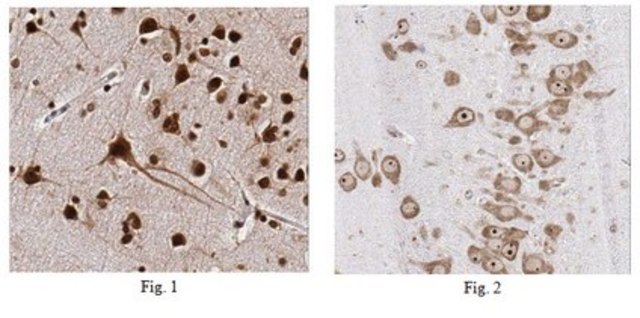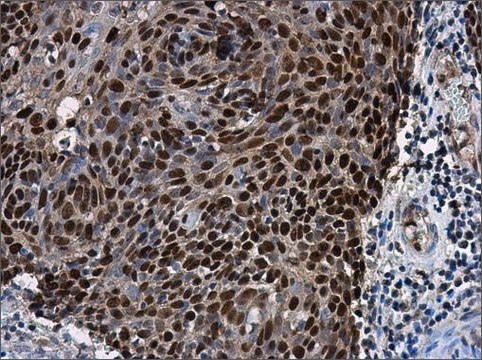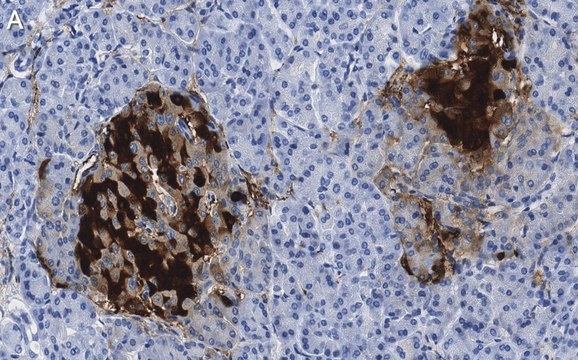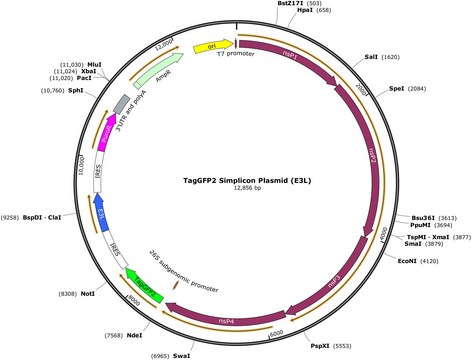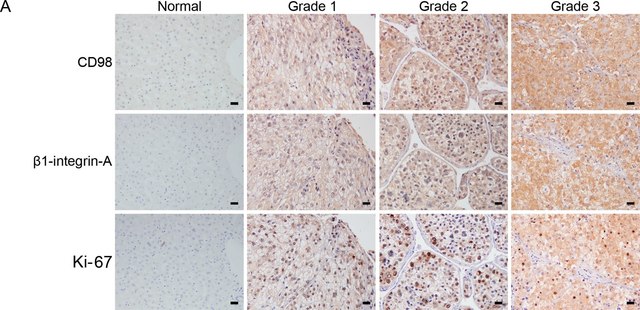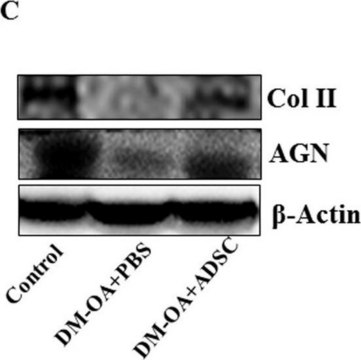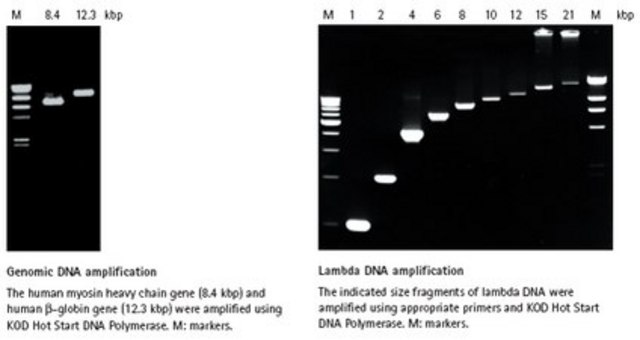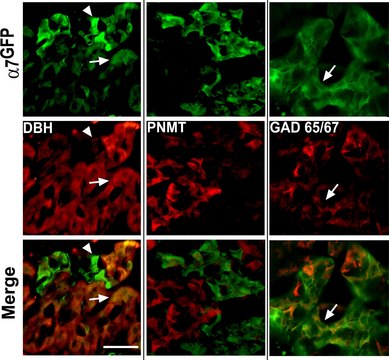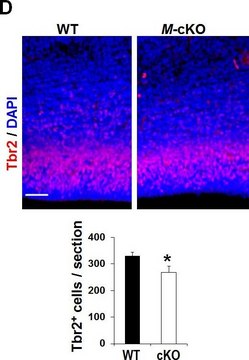MABN24
Anti-pan-Shank Antibody, clone N23B/49
clone N23B/49, from mouse
别名:
SH3 and multiple ankyrin repeat domains 2, SH3 and multiple ankyrin repeat domains protein 2, proline-rich synapse associated protein 1, cortactin SH3 domain-binding protein, Cortactin-binding protein 1, Proline-rich synapse-associated protein 1, cortact
登录查看公司和协议定价
所有图片(3)
About This Item
UNSPSC代码:
12352203
eCl@ss:
32160702
NACRES:
NA.41
推荐产品
生物来源
mouse
质量水平
抗体形式
purified antibody
抗体产品类型
primary antibodies
克隆
N23B/49, monoclonal
种属反应性
mouse, human, rat
技术
immunohistochemistry: suitable (paraffin)
western blot: suitable
同位素/亚型
IgG1κ
NCBI登记号
UniProt登记号
运输
wet ice
靶向翻译后修饰
unmodified
基因信息
human ... SHANK2(22941)
一般描述
Shank1, Shank2, and Shank3 make up a family of proteins that may function as molecular scaffolds in the postsynaptic density (PSD). Shank contains multiple domains for protein-protein interaction including ankyrin repeats, an SH3 domain, a PSD-95/Dlg/ZO-1 domain, a sterile α motif domain, and a proline-rich region. Alternative splicing in the Shank family may be a mechanism that regulates the molecular structure of Shank and the spectrum of Shank-interacting proteins in the PSDs of adult and developing brain.
免疫原
Recombinant protein consisting of SH3/PDZ domain of rat Shank2.
应用
Detect pan-Shank using this Anti-pan-Shank Antibody, clone N23B/49 validated for use in WB, IH(P).
Immunohistochemistry Analysis: 1:500 dilution from a previous lot detected Shank in rat cerebellum tissue.
Western Blot Analysis: A previous lot of this antibody detected Shank in extracts of COS-1 cells transiently transfected with Shank1, Shank2 or Shank3 plasmids. Courtesy of James Trimmer, UC Davis/NIH NeuroMab Facility.
Western Blot Analysis: A previous lot of this antibody detected Shank in extracts of COS-1 cells transiently transfected with Shank1, Shank2 or Shank3 plasmids. Courtesy of James Trimmer, UC Davis/NIH NeuroMab Facility.
Research Category
Neuroscience
Neuroscience
Research Sub Category
Synapse & Synaptic Biology
Synapse & Synaptic Biology
质量
Evaluated by Western Blot in rat brain membrane tissue lysate.
Western Blot Analysis: 2 µg/mL of this antibody detected Shank on 10 µg of rat brain membrane tissue lysate.
Western Blot Analysis: 2 µg/mL of this antibody detected Shank on 10 µg of rat brain membrane tissue lysate.
目标描述
~160 kDa observed. Other isoforms may be observed in some lysates.
外形
Protein G
Format: Purified
Purified mouse monoclonal IgG1κ in buffer containing 0.1 M Tris-Glycine (pH 7.4), 150 mM NaCl with 0.05% sodium azide.
储存及稳定性
Stable for 1 year at 2-8°C from date of receipt.
分析说明
Control
Rat brain membrane tissue lysate
Rat brain membrane tissue lysate
其他说明
Concentration: Please refer to the Certificate of Analysis for the lot-specific concentration.
免责声明
Unless otherwise stated in our catalog or other company documentation accompanying the product(s), our products are intended for research use only and are not to be used for any other purpose, which includes but is not limited to, unauthorized commercial uses, in vitro diagnostic uses, ex vivo or in vivo therapeutic uses or any type of consumption or application to humans or animals.
未找到合适的产品?
试试我们的产品选型工具.
储存分类代码
12 - Non Combustible Liquids
WGK
WGK 1
闪点(°F)
Not applicable
闪点(°C)
Not applicable
Marián Haburčák et al.
Frontiers in synaptic neuroscience, 14, 995474-995474 (2022-10-18)
The Spontaneously Hypertensive Rat (SHR) has increased sympathetic drive to the periphery that precedes and contributes to the development of high blood pressure, making it a useful model for the study of neurogenic hypertension. Comparisons to the normotensive Wistar Kyoto
Kenneth R Myers et al.
Frontiers in molecular neuroscience, 15, 1020949-1020949 (2022-10-18)
Dendritic spines are small actin-rich protrusions essential for the formation of functional circuits in the mammalian brain. During development, spines begin as dynamic filopodia-like protrusions that are then replaced by relatively stable spines containing an expanded head. Remodeling of the
Yusuke Hatanaka et al.
Scientific reports, 5, 16102-16102 (2015-11-05)
Late-onset neurodegenerative diseases are characterized by neurological symptoms and progressive neuronal death. Accumulating evidence suggests that neuronal dysfunction, rather than neuronal death, causes the symptoms of neurodegenerative diseases. However, the mechanisms underlying the dysfunction that occurs prior to cell death
我们的科学家团队拥有各种研究领域经验,包括生命科学、材料科学、化学合成、色谱、分析及许多其他领域.
联系技术服务部门